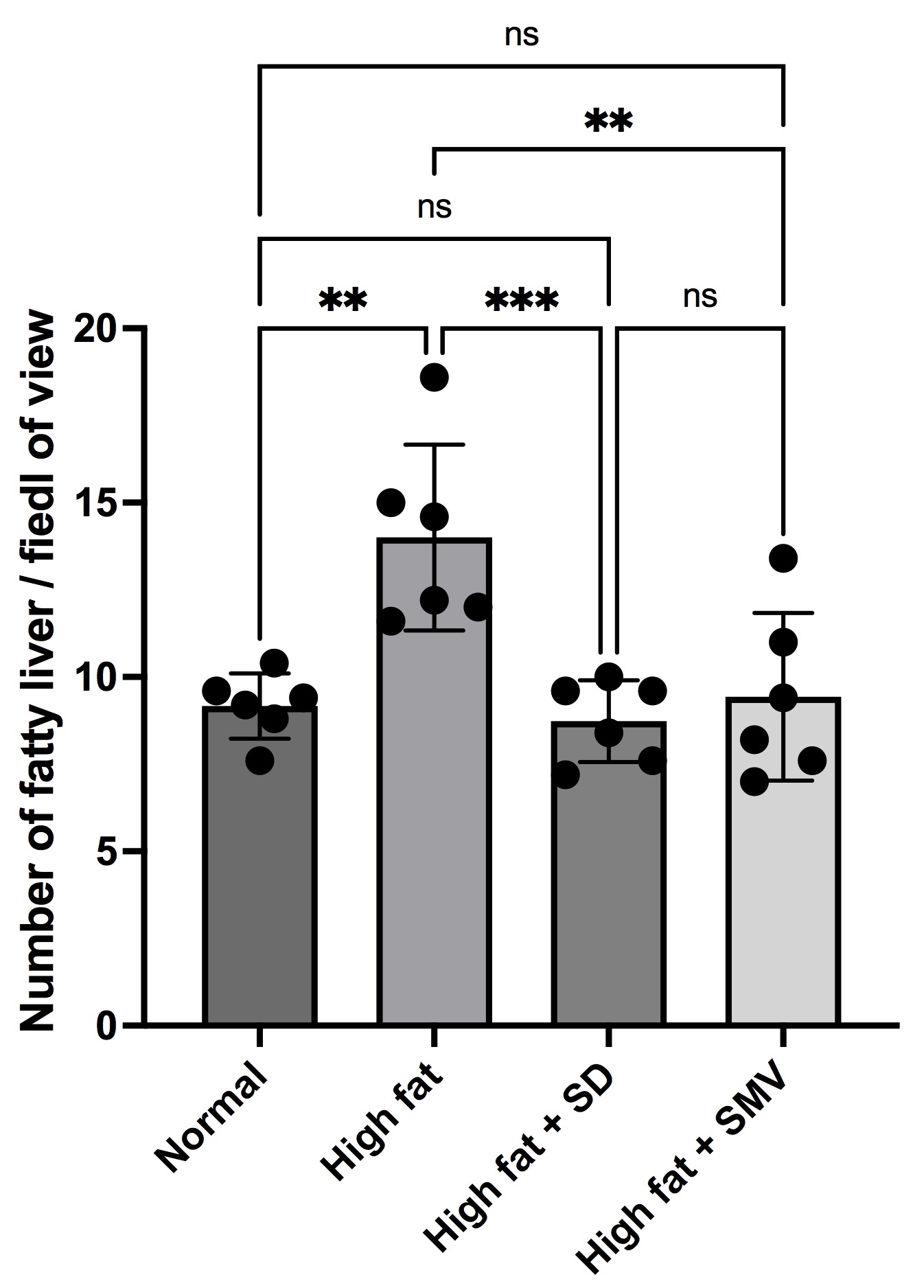Histopathological analysis of the liver in hypercholesterolemia rats treated with Dillenia serrata fruits
Abstract
Background: Dillenia serrata (locally known as singi) is a natural product with the potential to improve liver function in hypercholesterolemia, due to anticholesterol and antioxidant properties.
Objective: This study aimed to investigate the effect of D. serrata on the histopathological features of rat livers induced by a high-fat diet.
Methods: This study used a quasi-experimental in vivo with a post-test-only control group design. Rats were divided into four groups: normal, high-fat diet, as well as D. serrata, and simvastatin treatment. Hypercholesterolemia was induced by a high-fat diet for two weeks. Rat liver tissues were analyzed histologically using Hematoxylin-Eosin (HE) staining, and were observed under a light microscope at 40x magnification in five wide fields of view.
Results: The high-fat diet group had the most adipose cells, while the D. serrata group had the least. Statistical analysis demonstrated a significant difference between the high-fat diet group and the other groups (p < 0.05). Interestingly, no significant difference between the D. serrata group and either the normal or simvastatin group (p > 0.05), suggesting the treatment of fruit may restore liver function comparable to normal and simvastatin group.
Conclusion: The D. serrata fruit reduces the number of fat cells in the histopathology of rats induced with the high-fat diet.
References
Perumpail BJ, Khan MA, Yoo ER, Cholankeril G, Kim D, Ahmed A. Clinical epidemiology and disease burden of nonalcoholic fatty liver disease. World J Gastroenterol. 2017;23: 8263-8276. https://doi.org/10.3748/wjg.v23.i47.8263
Younossi ZM, Koenig AB, Abdelatif D, Fazel Y, Henry L, Wymer M. Global epidemiology of nonalcoholic fatty liver disease-Meta-analytic assessment of prevalence, incidence, and outcomes. Hepatology. 2016;64: 73-84. https://doi.org/10.1002/hep.28431
Stefan N, Häring H-U, Cusi K. Non-alcoholic fatty liver disease: causes, diagnosis, cardiometabolic consequences, and treatment strategies. Lancet Diabetes Endocrinol. 2019;7: 313-324. https://doi.org/10.1016/S2213-8587(18)30154-2
Godoy-Matos AF, Silva Júnior WS, Valerio CM. NAFLD as a continuum: from obesity to metabolic syndrome and diabetes. Diabetol Metab Syndr. 2020;12: 60. https://doi.org/10.1186/s13098-020-00570-y
Lian C-Y, Zhai Z-Z, Li Z-F, Wang L. High fat diet-triggered non-alcoholic fatty liver disease: A review of proposed mechanisms. Chem Biol Interact. 2020;330: 109199. https://doi.org/10.1016/j.cbi.2020.109199
Alves-Bezerra M, Cohen DE. Triglyceride metabolism in the liver. Compr Physiol. 2017;8: 1-8. https://doi.org/10.1002/cphy.c170012
Loomba R, Friedman SL, Shulman GI. Mechanisms and disease consequences of nonalcoholic fatty liver disease. Cell. 2021;184: 2537-2564. https://doi.org/10.1016/j.cell.2021.04.015
Ramkumar S, Raghunath A, Raghunath S. Statin therapy: review of safety and potential side effects. Acta Cardiol Sin. 2016;32: 631-639. doi:10.6515/acs20160611a
Rattanachaisit P, Susantitaphong P, Thanapirom K, Chaiteerakij R, Komolmit P, Tangkijvanich P, et al. Statin use and histopathological change in patients with non-alcoholic fatty liver disease: a systematic review and meta-analysis. Asian Biomed. 2018;12: 3-13. https://doi.org/10.1515/abm-2018-0026
Zhang J, Almoallim HS, Ali Alharbi S, Yang B. Anti-atherosclerotic activity of Betulinic acid loaded polyvinyl alcohol/methylacrylate grafted Lignin polymer in high fat diet induced atherosclerosis model rats. Arabian Journal of Chemistry. 2021;14: 102934. https://doi.org/10.1016/j.arabjc.2020.102934
Jalil J, Sabandar CW, Ahmat N, Jamal JA, Jantan I, Aladdin N-A, et al. Inhibitory effect of triterpenoids from Dillenia serrata (Dilleniaceae) on prostaglandin E2 production and quantitative HPLC analysis of its koetjapic acid and betulinic acid contents. Molecules. 2015;20: 3206-3220. https://doi.org/10.3390/molecules20023206
Novia D, Sugiarto S, Dewi YL. Pengaruh dosis dan lama pemberian ekstrak daun asam jawa (Tamarindus indica Linn) terhadap HOMA-Β pada tikus model diabetes mellitus tipe 2. MGI. 2021;16: 267. https://doi.org/10.20473/mgi.v16i3.267-272
Malve H, Asalkar A. Which LDL value should clinicians look at? J Lab Physicians. 2021;13: 129-133. https://doi.org/10.1055/s-0041-1729131
Swarayana IMI, Sudira IW, Berata IK. Perubahan Histopatologi Hati Mencit (Mus musculus) yang Diberikan Ekstrak Daun Ashitaba (Angelica keiskei). Buletin Veteriner Udayana. 2012;
Irnawati I. Penetapan kadar vitamin C dan uji aktivitas antioksidan sari buah songi (Dillenia serrata Thunb.) terhadap radikal DPPH. PHARMACON. 2017;
Sabandar CW, Jalil J, Ahmat N, Aladdin N-A, Kamaruddin HS, Wahyuningrum R. Aktivitas Antioksidan dan Penghambatan Xantin Oksidase Kulit Batang Songi (Dillenia serrata Thunb.). JFG. 2020;6: 151-159. https://doi.org/10.22487/j24428744.2020.v6.i1.15008
Biswas S, Das R, Ray Banerjee E, Immunobiology and Regernative Medicine Research laboratory, Department of Zoology, University of Calcutta, West Bengal, India. Role of free radicals in human inflammatory diseases. AIMS Biophys. 2017;4: 596-614. https://doi.org/10.3934/biophy.2017.4.596
Wu J, Huang G, Li Y, Li X. Flavonoids from Aurantii Fructus Immaturus and Aurantii Fructus: promising phytomedicines for the treatment of liver diseases. Chin Med. 2020;15: 89. https://doi.org/10.1186/s13020-020-00371-5
Xu T, Hu S, Liu Y, Sun K, Luo L, Zeng L. Hawk Tea Flavonoids as Natural Hepatoprotective Agents Alleviate Acute Liver Damage by Reshaping the Intestinal Microbiota and Modulating the Nrf2 and NF-κB Signaling Pathways. Nutrients. 2022;14. https://doi.org/10.3390/nu14173662
Kawser Hossain M, Abdal Dayem A, Han J, Yin Y, Kim K, Kumar Saha S, et al. Molecular Mechanisms of the Anti-Obesity and Anti-Diabetic Properties of Flavonoids. Int J Mol Sci. 2016;17: 569. https://doi.org/10.3390/ijms17040569
Zeka K, Ruparelia K, Arroo RRJ, Budriesi R, Micucci M. Flavonoids and their metabolites: prevention in cardiovascular diseases and diabetes. Diseases. 2017;5. https://doi.org/10.3390/diseases5030019
Shimizu K, Nishimuta S, Fukumura Y, Michinaga S, Egusa Y, Hase T, et al. Liver-specific overexpression of lipoprotein lipase improves glucose metabolism in high-fat diet-fed mice. PLoS One. 2022;17: e0274297. https://doi.org/10.1371/journal.pone.0274297
Zhong X, Zeng M, Bian H, Zhong C, Xiao F. An evaluation of the protective role of vitamin C in reactive oxygen species-induced hepatotoxicity due to hexavalent chromium in vitro and in vivo. J Occup Med Toxicol. 2017;12: 15. https://doi.org/10.1186/s12995-017-0161-x
Zainub A, Ayub F, Jahangir A, Inam T, Ayub S. Comparative Study of Betulinic Acid Versus Simvastatin on Total Cholesterol and HDL in Hyperlipidemic Model. Biomedica. 2018;34: 248-252.
Quan HY, Kim DY, Kim SJ, Jo HK, Kim GW, Chung SH. Betulinic acid alleviates non-alcoholic fatty liver by inhibiting SREBP1 activity via the AMPK-mTOR-SREBP signaling pathway. Biochem Pharmacol. 2013;85: 1330-1340. https://doi.org/10.1016/j.bcp.2013.02.007
Luo J, Wang J-K, Song B-L. Lowering low-density lipoprotein cholesterol: from mechanisms to therapies. Life Metab. 2022;1: 25-38. https://doi.org/10.1093/lifemeta/loac004
Abu-Tarboush H. Cholesterol and fat contents of animal adipose tissues. Food Chem. 1993;46: 89-93. https://doi.org/10.1016/0308-8146(93)90082-Q

Copyright (c) 2022 Authors

This work is licensed under a Creative Commons Attribution-NonCommercial 4.0 International License.







